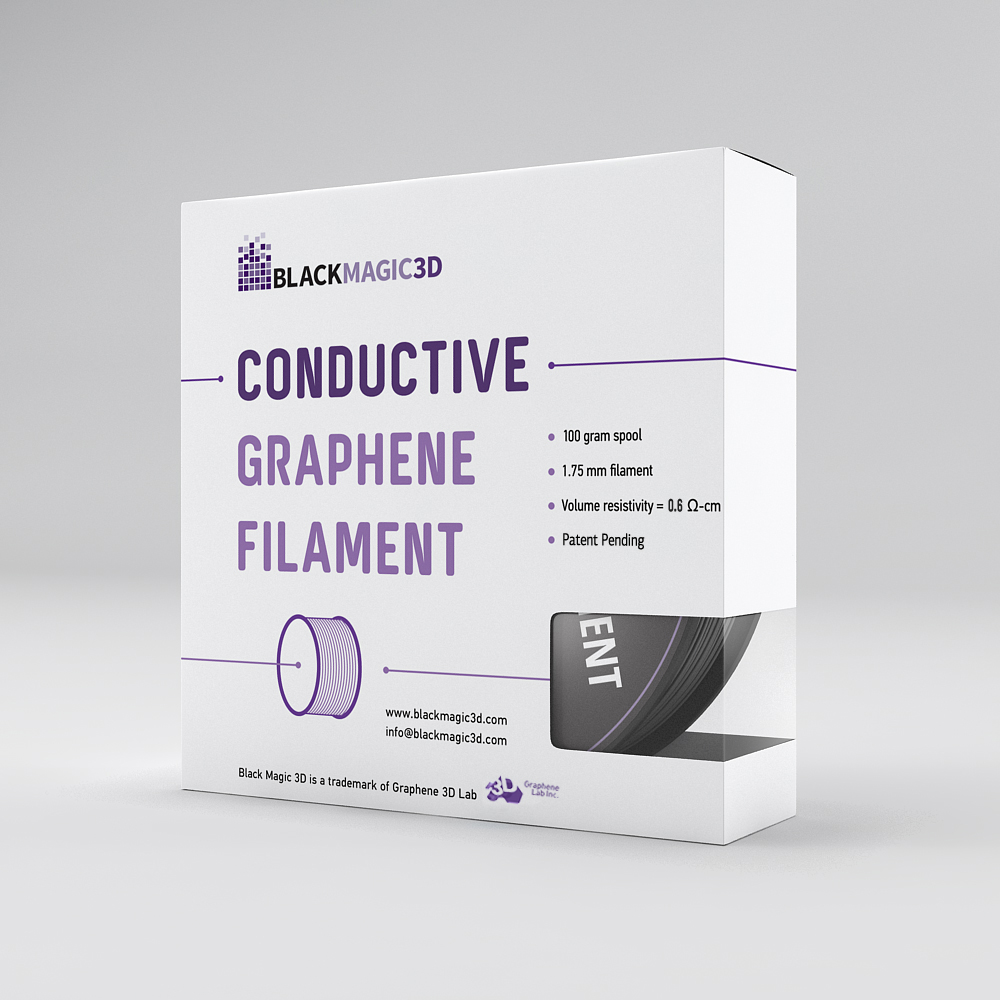Conductive Graphene Filament, a material by Graphene 3D Lab,
is specifically designed to allow you to 3D print electrically conductive
components using almost any commercially available desktop 3D printer! By purchasing this filament, you agree that you have read and agree to the product description below, including the handling and disclaimer statements.
Download our PDF flyer by clicking here!
Properties
- Volume Resistivity: 0.6 ohm-cm
- Color: Black
- Diameter: 1.75 mm
- Size: 100 grams
- Graphene-enhanced for superior conductivity and improved
mechanical properties
- PLA-based
Electrical Conductivity
Our Conductive Graphene Filament offers a volume resistivity
of
0.6 ohm-cm. Volume resistivity is the measure of a material’s resistance to
electricity within a cubic centimeter of material. In order to determine if the
material will work for your project, you will have to keep in mind that the
resistivity will change depending upon your print. It is suggested that our filament
can be used for the applications below.
High Strength
Conductive Graphene Filament may also be used for
applications which require superior strength to ABS and PLA.
Applications
Sensors
Conductive Graphene Filament can be used to create
capacitive (touch) sensors used in a wide range of electronics which you interact
with on a daily basis; it is an excellent material for designing human
interface devices! Capacitive sensing can also be used to measure proximity,
position, humidity, fluid levels, and acceleration.
Projects include:
- Gaming controllers
- Digital keyboards
- Trackpads
- Drum Machines
- MIDI controllers
Conductive Traces
Another application of Conductive Graphene Filament is in
the creation of electrically conductive circuitry for use in electronics. We
love that 3D printing is a push-button process and we aim to keep it that way.
Traditionally, 3D printing enthusiasts needed to add circuitry to their
creation after it was printed in plastic, using copper wire; by offering a conductive
filament, you can print graphene wiring simultaneously with your build process!
Projects include:
- Interfacing computers, Arduino boards, and other components
- Powering LED’s
- Wearable electronics
Note: The electrical resistance of a circuit must be
considered in order to successfully use Conductive Graphene Filament in
electronics applications; specifically, the filament is designed for
low-current applications.
Electromagnetic and Radiofrequency Shielding
The superior conductivity offered with our Conductive
Graphene Filament is not only excellent for 3D printed circuitry and sensors –
it also means our filament is wholly capable of use in EMI and RF shielding
applications critical for use in a range of industries, including:
- Telecommunications
- Hospital equipment

- Medical devices
- Enclosures and packaging
- Aerospace and Automotive
EMI/RF shielding is used to block the electromagnetic field
and radio frequency electromagnetic radiation within a space; it is important
to use EMI and RF shielding in a hospital, laboratory, or aerospace setting to
protect against competing signals because they may lead to equipment giving
false measurements. EMI/RF shielding accomplishes this by blocking AM, FM, TV,
emergency services, and cellular signals.
Conductive Graphene Filament is ideal for designing EMI/RF
shields used in highly-customized items.
High-Strength mechanical and functional parts
Because Conductive Graphene Filament is mechanically
stronger than ABS and PLA, it can be used to 3D print functional parts such as:
hooks, hand-tools, and parts which require tooling, including drilling.
Handling
Our filament is shipped in a vacuum-sealed package with a
desiccant packet. Conductive Graphene Filament should be stored in a dry
environment away from dust and other particles. User should avoid extended exposure to moisture. We recommend storing in an enclosed container with a desiccant packet. 3D printers, especially their nozzles, should always be
maintained, and should be cleaned before and after use of Conductive Graphene
Filament to avoid complications during printing. Users are also instructed to
wash their hands before and after use of Conductive Graphene Filament.
Conductive Graphene Filament softens at high-temperatures
(~50°C) and is designed to be used with prints intended for room-temperature
operation; it is intended for low-voltage and low-current projects only. Do not
exceed 12 volts and avoid using the filament for power supply’s that exceed 100
mA. Resistivity of one meter of 1.75 mm filament is 4 kOhm’s. Keep in mind that
a major factor influencing resistivity is contact resistivity, so shortening
the length of the trace will not linearly correlate to a decrease in
resistivity.
The intrinsic properties of our Conductive Graphene Filament is such that it
should not be left idle (as in not extruding or printing) in a heated printer
nozzle. It may expand and cause blockage. After the printing is complete, remove filament from the nozzle promptly.
If using this material for dual-extrusion printing, we recommend using in conjunction with PLA.
A 3D printer nozzle larger than 0.5 mm is suggested for use
of Conductive Graphene Filament.
Interested in our conductive filament in pelletized form or
other custom projects? Contact us today at
[email protected] or by phone
at (631) 405-5116.
Disclaimer
Our materials and products may be used by skilled,
experienced users, and at their own risk. To the fullest extent permissible by
all applicable laws, we hereby disclaim any and all responsibility, risk,
liability, and damages arising out of any death or personal injury resulting
from the assembly or use of our products and materials. Specifications are
subject to change without notice.
MSDS can be found here:
Conductive Filament MSDS